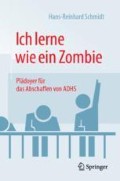Zusammenfassung
Die Auffassungen, was ADHS eigentlich sei, gehen weit auseinander: von der Entwicklungsstörung der Selbstkontrolle über eine genetisch bedingte Hirnfunktionsstörung bis zur grundlegenden Dysfunktion des kortikal-striatalen Netzwerks, ja bis zur Auffassung, es handele sich um gar keine Krankheit, sondern nur um ein bloßes „Anderssein“. Mittels internationaler Diagnosekataloge, die unterschiedliche Kriterien angeben, werden umfangreiche Symptomlisten zur Diagnose angewendet, Subtypen mit oder ohne Hyperaktivität beschrieben, sodass sich dem unbefangenen Leser ein verwirrendes und konfuses Gesamtbild zeigt.
Access this chapter
Tax calculation will be finalised at checkout
Purchases are for personal use only
Literatur
Adams, Z. W., Derefinko, K. J., Milich, R., & Fillmore, M. T. (2008). Inhibitory functioning across ADHD subtypes: recent findings, clinical implications, and future directions. Developmental Disabilities Research Reviews, 14(4), 268–275.
ADHS Deutschland. (2018). http://www.adhs-deutschland.de/Home/ADHS/ADHS-ADS/Was-ist-ADHS.aspx. Zugegriffen: 1. Aug. 2018.
Angold, A. et al. (August 2000). Stimulant treatment for children: A community perspective. Journal of the American Academy of Child and Adolescent Psychiatry, 39(8).
Barbaresi, W. J., Katusic, S. K., Colligan, R. C., Pankratz, V. S., Weaver, A. L., Weber, K. J., et al. (2002). How common is attention-deficit/hyperactivity disorder? Incidence in a population-based birth cohort in Rochester, Minn. Archives of Pediatrics and Adolescent Medicine, 156, 217–224.
Barkley, R. A. (2002). International consensus statement on ADHD. Journal of the American Academy of Child and Adolescent Psychiatry, 41(12), 1389.
Deutsche Bundesärztekammer. (2005). Stellungnahme zur Aufmerksamkeitsdefizit-/Hyperaktivitätsstörung (ADHS). http://www.bundesaerztekammer.de/downloads/ADHSLang.pdf. Zugegriffen: 31. Juli 2018.
Diamond, A. (2005). Attention-deficit disorder (attention-deficit/ hyperactivity disorder without hyperactivity): A neurobiologically and behaviorally distinct disorder from attention-deficit/hyperactivity disorder (with hyperactivity). Development and Psychopathology, 17(3), 807–825.
Döpfner, M., Frölich, J., & Lehmkuhl, G. (2000). Hyperkinetische Störungen. Göttingen: Hogrefe.
Douglas, V. I. (1983). Attentional and cognitive problems. In M. Rutter (Hrsg.), Developmental Neuropsychiatry. New York: Guilford.
Grizenko, N., Paci, M., & Joober, R. (2009). Is the inattentive subtype of ADHD different from the combined/hyperactive subtype? Journal of Attention Disorders. https://doi.org/10.1177/1087054709347200.
Hartmann, T. (2001). Eine andere Art, die Welt zu sehen. Das Aufmerksamkeits-Defizit-Syndrom (9. Aufl.). Lübeck: Schmidt-Römhild.
Internationale Klassifikation psychischer Störungen (ICD, Kapitel V) (2016). Göttingen: Hogrefe.
Lilly Pharma (2015). ADHS. www.lilly-pharma.de/gesundheit/adhs/index.asps.
Mannuzza, S., Klein, R. G., Klein, D. F., Bessler, A., & Shrout, P. (2002). Accuracy of adult recall of childhood attention deficit hyperactivity disorder. The American Journal of Psychiatry, 159(11), 1882–1888.
MedizInfo. (2018). Diagnosekriterien. http://www.medizinfo.de/kinder/probleme/diagnosekriterien.htm. Zugegriffen: 13. Aug. 2018.
Neuhaus, C. (1999). Das hyperaktive Kind. Ravensburg: Ravensburger.
Rothenberger, A., Döpfner, M., Sergeant, J., & Steinhausen, H. C. (2004). ADHD – beyond core symptoms. Not only a European perspective. European child & adolescent psychiatry, 13.
Seidler, E. (2004). „Zappelphilipp“ und ADHS: Von der Unart zur Krankheit. Deutsches Ärzteblatt, 101(5), A-239/B-207/C-199.
Author information
Authors and Affiliations
Corresponding author
Rights and permissions
Copyright information
© 2019 Springer Fachmedien Wiesbaden GmbH, ein Teil von Springer Nature
About this chapter
Cite this chapter
Schmidt, HR. (2019). ADHS: Was soll das sein?. In: Ich lerne wie ein Zombie. Springer, Wiesbaden. https://doi.org/10.1007/978-3-658-14130-1_2
Download citation
DOI: https://doi.org/10.1007/978-3-658-14130-1_2
Published:
Publisher Name: Springer, Wiesbaden
Print ISBN: 978-3-658-14129-5
Online ISBN: 978-3-658-14130-1
eBook Packages: Psychology (German Language)

